This was published 8 years ago
India's must-see city: Jaipur is a pink riot of colour and history
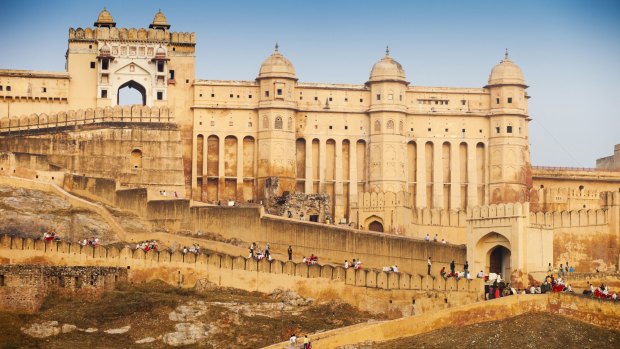
Amber Fort, Jaipur.
Our chirpy driver Ram Niwas pilots the car through the dense traffic, tactically moving his way around the narrow Jaipur roads as our Pure India Collection guide Praveen Agarwal begins to deliver his Jaipur spiel. "This is the largest city in one of India's most-visited states. There is much to see."
I don't doubt Praveen. My husband and I arrived into Jaipur at dusk the previous night and it was immediately obvious to us that Jaipur warrants, at minimum, a few days visit. Although we left Delhi in the morning, (Jaipur is about a five-hour drive from Delhi) by the time we stopped for creamy paneer curry at a roadside restaurant and then popped into Galtaji, the evening was beginning to set in.
The sojourn at Galtaji was worth it. Although the Hindi temple complex is just 10 kilometres from the centre of Jaipur, not many tourists venture here. It's a little pocket of serenity where animated monkeys outnumber humans and the few locals that are around don't seem to be bothered by a handful of tourists. We feed peanuts to the monkeys and watch a family of pilgrims bathe in one of the sacred natural water spring tanks (called kunds). It's a peaceful start to Jaipur … and short-lived.
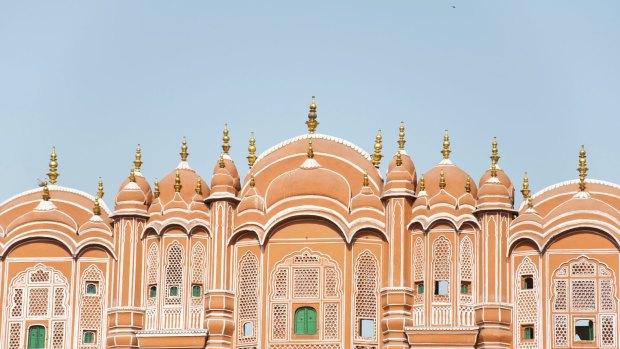
The famous Hawa Mahal, 'Palace of Winds', in Jaipur.
Exploring the old city of Jaipur is the opposite of peaceful. The chaotic racket of everyday life, the wafts of incense and camphor, and the scent of spicy curries brewing is intoxicating. Although Praveen has ideas on which route to take, I find the best way to soak it up is to explore with no specific intention, stopping in at street-side shops manned by chatty craftsmen, snacking on fried tidbits (try the spicy lentil-based puff pastries called dal kachoris and potato-and-onion cutlets called aloo tikki) along the way, and getting lost deliberately.
Although we've deviated from Praveen's program, an hour or so later he starts his official tour. "Jaipur got the name Pink City in 1876," he explains. "The Prince of Wales [Edward VII] was visiting and in his honour Maharaja Sawai Ram Singh painted all royal and official buildings pink." Praveen pauses and chuckles watching us as we inquisitively gaze at the other pink buildings. "The locals decided to paint many of the other buildings pink too."
Perhaps Jaipur's most famous pink building, the five-storey crown-shaped Hawa Mahal (Palace of Winds), is as pink as they come. The extension to the City Palace was constructed from pink sandstone in 1799, it was then pink-washed an even brighter pink with calcium oxide paint in 1876. That's not the most interesting feature about the build, however. Hawa Mahal was constructed so that royal women could observe daily street life and the tiny, intricate latticework windows (which are said to resemble the honeycomb of a bee's nest) were crafted slanting so that the royal women were able to see the main market and central boulevard, but passers-by could not see in.
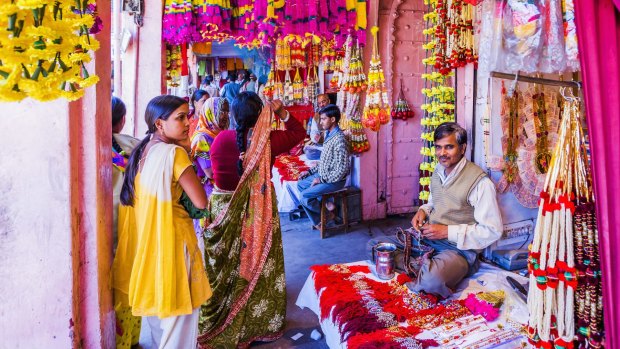
Flower seller near Badi Chaupar.
We pass many buildings with tiny windows (none as elaborate as the windows of Hawa Mahal) and I attempt to glimpse inside. I know it's a tad voyeuristic, but my imagination is running wild picturing life both present and past. Although I can't see inside any of buildings, as we thread our way through the historic old town Praveen divulges stories about former maharajas and maharanis – feeding us a taster of what life was like once upon a time Jaipur.
I make do watching the people of today. Tittering women donning brightly coloured saris stride alongside each other, a kaleidoscope of vibrant hues swirling as their shiny trinkets shimmer in the hot sun. The men jump between haggling passersby, chatting to each other, and drinking endless cups up masala chai. Although it's incredibly busy, traffic (humans, bikes, cars and cattle) seems to flow systematically.
Founded in 1727 by Maharaja Sawai Jai Singh II, Rajasthan's capital is India's fist planned city. A mathematics and science enthusiast, the king designed the city layout following the principles of Vastu Shastra (an Indian design and construction discipline). Two blocks were allocated to governmental buildings and the remaining seven blocks were designated for public housing. It seems the methodical design still aids people today.
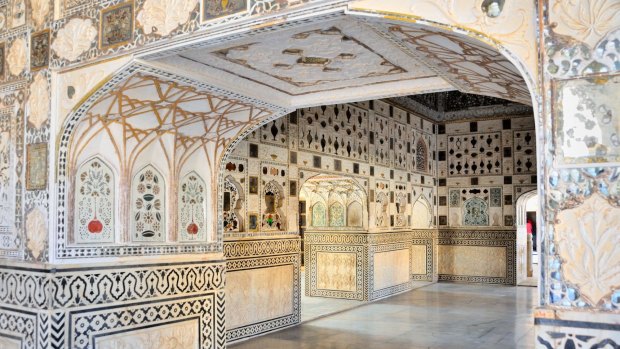
Hall of Mirrors, Amber Fort, Jaipur.Credit: Alamy
The City Palace is one of the old city's marvels and a sector of it is still home to the royals today. The sprawling patchwork of sizeable courtyards, luscious green gardens and well-designed buildings is mix of Mughla and traditional-style design and is one of Jaipur's most-visited attractions.
Away from the tourists and just a stone's throw from the City Palace, the area surrounding Talkatora Lake is a pleasant place to take a leisurely stroll. The lake was used as alligator tank in times of maharajas, but recently it has been restored into a public space. It's a charming spot anytime of day, but mid afternoon is particularly enchanting. As the sun drops low, so does the temperature, and with that the locals come out to play. Watching life unravel while snacking on bhujia (similar to soy crisps but made with gram flour) – well that's real India.
We retire to our hotel, Taj Hotels' Rambagh Palace, happily exhausted. Although we've spent the day negotiating the old town's streets, we can't help but continue on the same path, drifting through the grounds and moseying our way into every nook and cranny before it gets dark.
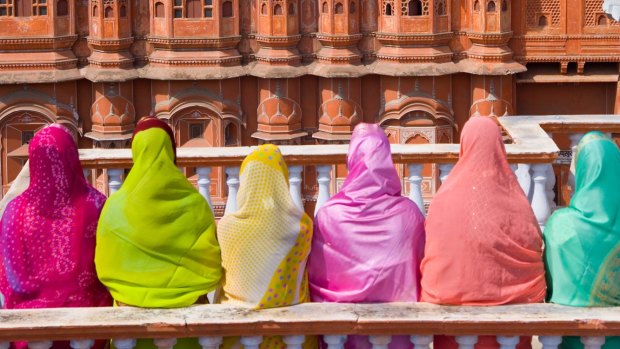
Women in bright saris in front of the Hawa Mahal (Palace of the Winds), built in 1799.
The Rambagh Palace is the former residence of Maharaja Sawai Man Singh II and it's a spectacular example of architectural grandeur and plain old-fashioned magnificence. Jaipur is the city of palaces and forts and to be staying in a former palace so beautifully and thoughtfully restored – well that's also the real India but in a completely different sense. Guests staying here are treated like royalty – pampered and their every whim attended to.
We carefully stride across the shimmering marble floors, taking in every minute detail in. Intricate Rajasthani motifs adorn the walls; we pass extraordinarily detailed stonework; admire beautifully carved pillars; and twist our heads upwards to appreciate the elaborate crystal chandeliers dangling from the high ceilings.
Retiring to our room with its four-poster bed, walk-in wardrobe, hand-painted wall motifs and decorative textured silks is surreal. We look out through our gold-tinted window over the courtyard and are rewarded with a serenade from the resident bansuri (bamboo flute) musician.
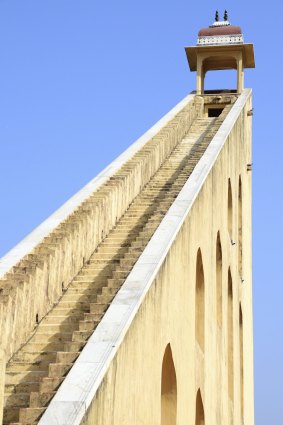
Stairway To The Stars, Jaipur.
The next day Praveen wants to show Jaipur's three main forts and he insists we visit the famous Amber Fort first. Ram drives slowly towards the massive complex so that we can appreciate the picturesque setting of the ancient former capital. Flanked by a lake on one side and rolling hills on the other sides, its exterior is made even more glorious in the morning sun.
Inside the fort is just as magnificent and we spend hours negotiating our way through the crowds. My favourite space by far is the dazzling Sheesh Mahal (Palace of Mirrors). The walls and ceiling are adorned with thousands of mirror fragments, colourful mosaics and intricate flower carvings. The mirrors reflect the flickering colours, which results in dancing illuminations. Praveen explains that the king ordered the hall to be built so that the queen would be able to stargaze whenever she so desired. The maharani wasn't allowed to sleep outside, but thanks to the ingeniously designed space, the light from just one candle gives the appearance of a thousand stars.
We head to Jaigarh Fort, on the ridge overlooking Amber Fort, next. I amble around the estate while the boys examine the world's largest wheeled cannon. Our last fort stop for the day is Nahargarh Fort. Located ona hilltop, it's the smallest of the three forts, but the views of Jaipur city from here are unrivalled. As the day's last rays of sun salsa over the pink city we all stand and gape. Even Praveen, who has lived in Jaipur for most of his life, looks impressed. A city painted pink for a prince, a king that built a room of stars for his queen… Jaipur is a truly impressive city.
FIVE MORE THINGS TO DO IN JAIPUR AND SURROUNDS
SOAR OVER THE CITY
One thing no one gets sick of in Jaipur is the view. Float over the pink city in a hot air balloon and observe life from a bird's eye view. See skywaltz.com.
SHOP FOR JEWELLERY
Jaipur is considered to be one of the world's leading gemstone hubs and if you only visit one shop, make it the Gem Palace – jeweller to royals since 1852. See gempalacejaipur.com.
LEARN ABOUT THE SUN AND THE STARS
Built in the early 18th century, the UNESCO World Heritage site of Jantar Mantar was one of the most accurate astronomical instruments of its time.
VISIT INDIA'S MOST HAUNTED PLACE
It's a two-hour drive from Jaipur, but if you're into freaky stuff it's worth it. The abandoned fort of Bhangarh is said to be so haunted that sightseers are only permitted to visit between sunrise and sunset. Locals have even moved their town beyond the vicinity of the fort.
CHILL OUT
At the end of the day take the time to nourish your body with the ancient Indian practice of yoga. Rambagh Palace guests can partake in Bihar School of Yoga classes at the yoga pavilion, focusing on breathing and meditation. See tajhotels.com.
TRIP NOTES
MORE INFORMATION
GETTING THERE
Air India flies to Delhi direct from Sydney and Melbourne and then onto Jaipur. See airindia.in or call 1800 247 463.
SEE + DO
Pure India Collection is designed to be the ultimate in enriching and unique luxury travel experiences. Itineraries are fully customised and include accommodation, activities, guides, drivers and transfers. See pureindiacollection.com.au or call 1300 365 060.
SLEEPING THERE
Stay at Taj Hotels' Rambagh Palace and enter another realm, one where your every desire is fulfilled (I swear the staff are trained to read minds). See tajhotels.com.
The writer travelled as a guest of Pure India Collection and Air India.
Sign up for the Traveller Deals newsletter
Get exclusive travel deals delivered straight to your inbox. Sign up now.